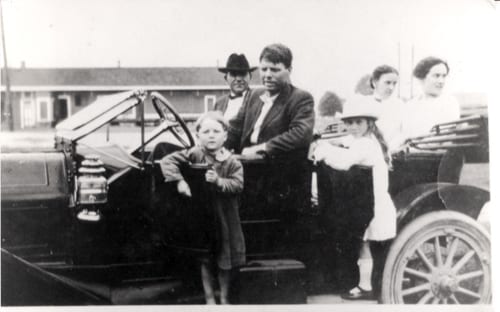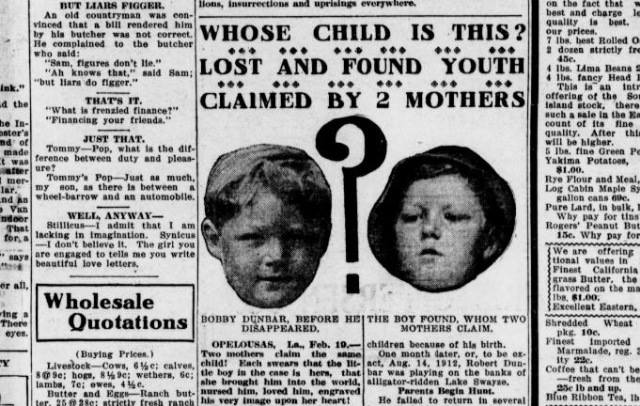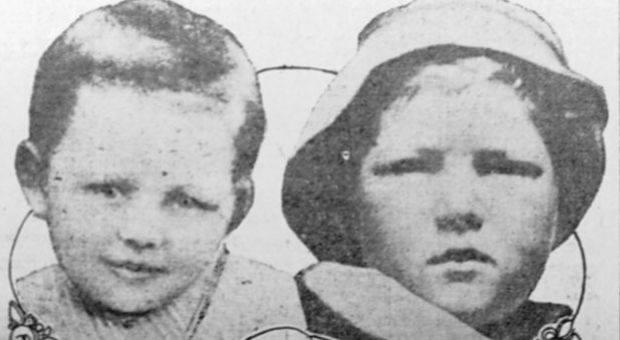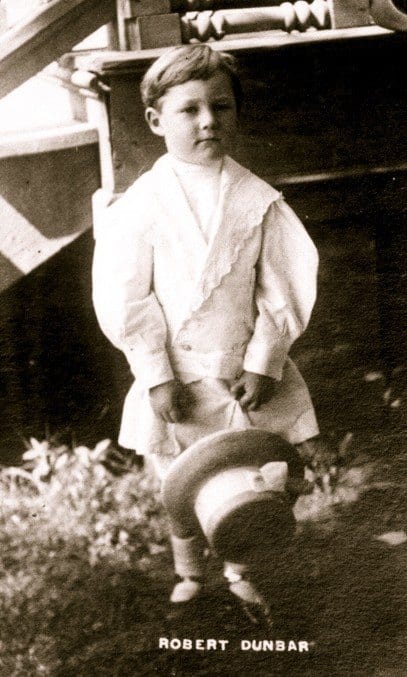On August 23, 1912, 4-year-old Bobby Dunbar disappeared “like magic.” He was on a weekend camping trip with his parents and their friends, and had been watching a man named Paul Mizzi shoot fish in the murky water of Swayze Lake (near Opelousas, Louisiana). His mother was back at the camp, preparing food and looking after Bobby’s 2-year-old brother, Alonzo.

Photo Credit: Facebook, Carola Lillie Hartley
When she called everyone for the noon meal, Bobby didn’t return. Mizzi said that they had been walking back together, the little boy sassing him as Mizzi told him to get out of the way, and that was the last he saw of him.

Photo Credit: Pixabay
Though 100 people joined the search, even dragging and cutting open alligators and setting off dynamite in the water in an attempt to recover a body, no trace of Bobby Dunbar was found. Percy and Lessie, Bobby’s parents, had money and influence and were able to offer upwards of $5000 for information leading to the recovery of their son (in the event he was lost or kidnapped and not dead). Percy traveled to orphanages around the region in search of his little boy. Tips rolled in, all of which were deemed to be false leads. One in particular would become of further interest later on – a sighting of a boy matching Bobby’s description in Poplarville, MS. He was supposedly seen in the company of a tinker and itinerant worker, but when Percy’s brother, Archie, went to check it out, he reported back that the boy wasn’t Bobby.

Photo Credit: Wikipedia
Eight months passed without news, and the Dunbars were at loose ends – unsure whether to give up and grieve or to keep searching. In April of 1913, the couple received a telegram from Columbia, MS, again stating that a boy in the company of a tinker looked a lot like their Bobby. This time, Percy and Lessie went themselves to decide whether this might be their boy, after all.

Photo Credit: Wikipedia
The tinker was William Cantwell Walters, and he insisted the boy’s name was Bruce Anderson, was his nephew, and had been entrusted to him by his mother, Julia Anderson.
When the Dunbars arrived and Lessie laid eyes on the boy for the first time, some accounts state that she was uncertain whether or not he was Bobby – his eyes were too small. The boy insisted his name was Bruce and shrunk away from his “mother.” But when Lessie was permitted to give him a bath the following day, she said that certain marks on his body convinced her that he was, in fact, her son. The boy, too, had a change of heart and embraced his “mama.”

Photo Credit: Facebook, Metronome
The family returned home to much pomp and circumstance, though some accounts hinted at the fact that there remained some uncertainty as to whether this Bobby was their Bobby. The Los Angles Times wrote, “…they hope that the environment of their home will reawaken some memories in his mind by which they will be more certain,” which certainly sounds as if little “Bobby” wasn’t acting like the boy who had been lost.
Meanwhile, the trial of William Cantwell Walters was looming. He had figured that having Julia Anderson come and identify her son back in Mississippi would have closed the door, but like Lessie, the woman had hesitated when asked whether the tot was Bruce. Things went no better during the trial, when she was unable to come to court because of an illness.

Photo Credit: Facebook, The Bizarre and The Curious
An Opelousas court convicted a stunned Walters in two weeks, even though the tinker continued to protest his innocence. His sentence of life imprisonment was never carried out, however, as his lawyer successfully argued that the LA kidnapping law that was used to charge him was unconstitutional. He went free. Julia Anderson married (not Walters’ brother) and started a new family.

Photo Credit: Maxpixel
Life went on. Bobby Dunbar grew up and worked as a salesman for Briggs Electrical Supply, marrying and fathering four children and never seeming to question his place in the family before he died of a heart attack in 1966.

Photo Credit: Criterion Collection
That might have been the end of it had not Margaret Dunbar Cutright, Bobby’s granddaughter, become entranced with the case in 1999. She had a massive scrapbook of newspaper clippings that were full of Lessie’s initial uncertainties and the case file compiled by Walters’ attorney, which included testimony from more than one person who had seen Walters and Bruce together prior to the disappearance. She became convinced that the recovered Bobby Dunbar had actually been Bruce Anderson, and in 2004 – thanks to modern DNA testing – was able to prove that her grandfather had no relation to her great-uncle, Alonzo.

Photo Credit: Facebook, BOX of the Weird & Bizarre
We may never know for sure whether or not he was Bruce Anderson, but it now seems that he most likely was. We’ll also probably never know why everyone involved – from Julia Anderson to Bobby (Bruce) to the Dunbars – became complicit in the whole mess. People aren’t as simple to unravel as DNA, of course, but to my mind, there are motives on all accounts.

Photo Credit: Facebook, Carola Lillie Hartley
Julia Anderson might have glimpsed the possibility of a better life for her son. Little Bruce may have tired of following Walters around in poverty and scented a whole new world of loving families, rides on fire trucks, and the like. As far as the Dunbars, well, grief is a powerful emotion that can easily get away from you.
Perhaps the most haunting scrap of proof comes from a letter Lessie Dunbar wrote to her granddaughter in 1920, shortly after her divorce from Percy. The poor mother confessed to being a “shell of grief,” which could certainly describe a broken family, a forever-missing eldest son, or the regret of never facing the facts before bringing home a replacement.

Photo Credit: Murderpedia
If you’re interested in more details regarding the case, Cutright has written a book called A Case For Solomon. You can buy it here.






